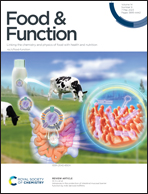Inhibition of Ca2+-calpain signaling is a new mechanism using Laminaria japonica polysaccharide to prevent macrophage foam cell formation and atherosclerosis†
Abstract
The Ca2+-calpain signaling plays a pivotal role in regulating the upstream signaling pathway of cellular autophagy. The aim of the current work was to investigate the role of Ca2+-calpain signaling in the regulation of macrophage autophagy by a Laminaria japonica polysaccharide (LJP61A) in Ox-LDL induced macrophages and high fat diet fed atherosclerotic mice. Results revealed that the LJP61A markedly decreased the levels of intracellular Ca2+, calpain1, calpain2 and their downstream effectors (Gsα, cAMP and IP3), and simultaneously enhanced autophagy activity and lipid metabolism, thereby reducing lipid accumulation in the Ox-LDL stimulated macrophages and lipid-laden plaques in atherosclerotic mice. Moreover, BAPTA-AM (a Ca2+ chelator) and calpeptin (a calpain inhibitor) synergistically strengthened the beneficial effects of LJP61A on autophagy and lipid metabolism by decreasing the levels of intracellular Ca2+, calpain1, calpain2, and their downstream effectors (Gsα, cAMP and IP3) induced by Ox-LDL. These findings suggested that the LJP61A suppressed macrophage derived foam cell formation and atherosclerosis by modulating the Ca2+-calpain-mediated autophagy.

- This article is part of the themed collection: Food & Function HOT Articles 2023


 Please wait while we load your content...
Please wait while we load your content...